
Shortwave vs. Superhuman: The Executive’s 2025 Guide to AI Email for Business
July 28, 2025 / Bryan ReynoldsIntroduction: Your Inbox Isn't a To-Do List—It's Your Business's Command Center
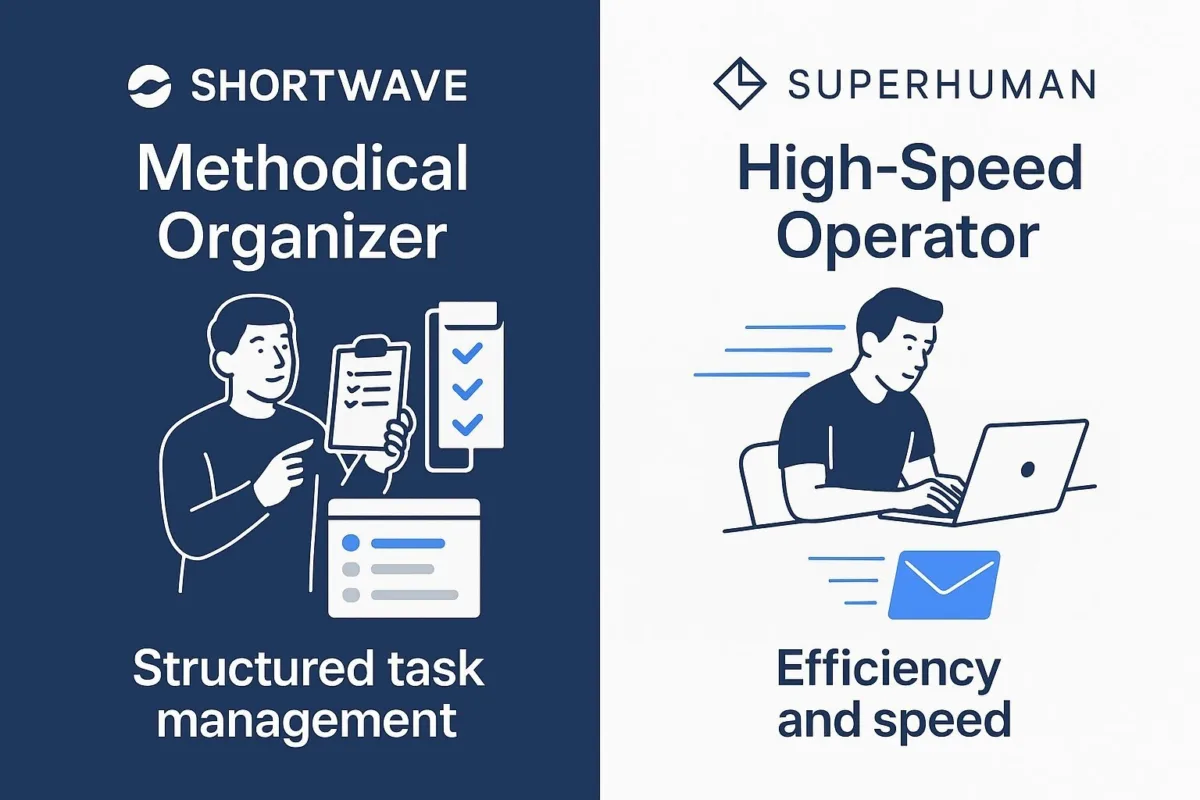
For today's executive, email is far more than a communication channel; it is the central nervous system of the business. It's where strategies are debated, deals are negotiated, teams are managed, and critical decisions are finalized. Yet, the standard email clients that most organizations rely on—like the native interfaces of Gmail and Outlook—were designed for a different era. They are fundamentally passive repositories, often becoming a source of stress and a black hole for productivity rather than a tool for strategic command. The sheer volume and complexity of modern business communication demand a more intelligent, responsive, and powerful interface.
This gap has given rise to a new category of AI-native email clients, engineered from the ground up to restore order and accelerate productivity. Two platforms have emerged as the clear leaders in this space: Shortwave and Superhuman. Both promise to transform the email experience, but they do so with vastly different philosophies, feature sets, and strategic implications.
As a leader—whether a CTO evaluating tech stacks, a CFO scrutinizing ROI, or a Head of Sales demanding peak team performance—choosing the right platform is a significant strategic decision. At Baytech Consulting, we guide leaders through complex technology choices by providing clear, unbiased, and actionable analysis. Following the "They Ask You Answer" approach, this report will address the most pressing questions executives have about these tools. It will dissect their core philosophies, validate their time-saving claims, conduct a deep feature comparison, analyze their costs, and explore the long-term implications of your choice, so you can make a confident decision that aligns with your business objectives.
Section 1: A Tale of Two Philosophies: The Intelligent Organizer vs. The High-Speed Operator
The most critical distinction between Shortwave and Superhuman lies not in a single feature, but in their foundational design philosophies. One is built to bring methodical order to chaos, while the other is engineered for pure operational velocity. Understanding this difference is the first step in determining which tool aligns with your team's core function and workflow.
Shortwave: The Methodical Organizer
Shortwave is best understood as an "opinionated email client". It is built around a specific workflow, the "Shortwave Method," which provides a structured approach to achieving and maintaining inbox zero. This methodology is a form of email triage, compelling users to process their inbox by systematically categorizing every message into one of three buckets: non-actionable items to be archived, quick tasks to be handled immediately, and longer tasks to be converted into trackable to-dos.
Born as a spiritual successor to the much-loved Google Inbox, Shortwave's primary goal is to transform a cluttered inbox into an organized, manageable workspace. Its core mechanism for this is "bundling," which intelligently groups related emails like newsletters, notifications, and updates for efficient batch processing—a feature many users mourned when Google retired Inbox. The entire user experience is designed to be "fast and joyful," aiming to change a user's relationship with email from one of dread to one of control.
Superhuman: The Velocity-Driven Operator
In contrast, Superhuman has a singular, laser-focused mission: to be the "fastest email experience ever made". Every aspect of the platform is optimized for speed, promising to get users through their inbox "twice as fast" as traditional clients.
This philosophy is most evident in its keyboard-centric workflow. Superhuman is designed to be operated almost entirely without a mouse, with an extensive library of keyboard shortcuts that allow power users to read, reply, and manage emails at the speed of thought. This is complemented by a stark, minimalist interface, intentionally stripped of the visual clutter and distracting elements common in other clients. The design promotes deep focus, preventing users from getting sidetracked and enabling them to execute tasks with maximum efficiency.
These differing philosophies are not merely marketing positions; they represent fundamentally different solutions to the problem of email overload. Shortwave's structured, "opinionated" methodology reflects a design that prioritizes process and organization. It wants to help you
organize the work. Superhuman's relentless emphasis on speed and keyboard shortcuts reflects a design centered on rapid execution. It wants to help you
execute the work faster. This distinction has profound implications for business leaders. A CTO managing an engineering team might find that Shortwave's methodical, to-do-list-oriented approach mirrors the structured principles of agile development. Conversely, a Head of Sales, whose team's success is measured by response time and deal velocity, will likely see Superhuman's speed-first philosophy as a direct match for their operational goals. The choice, therefore, begins not with a feature list, but with an analysis of which core philosophy best aligns with a specific team's function and measures of success.
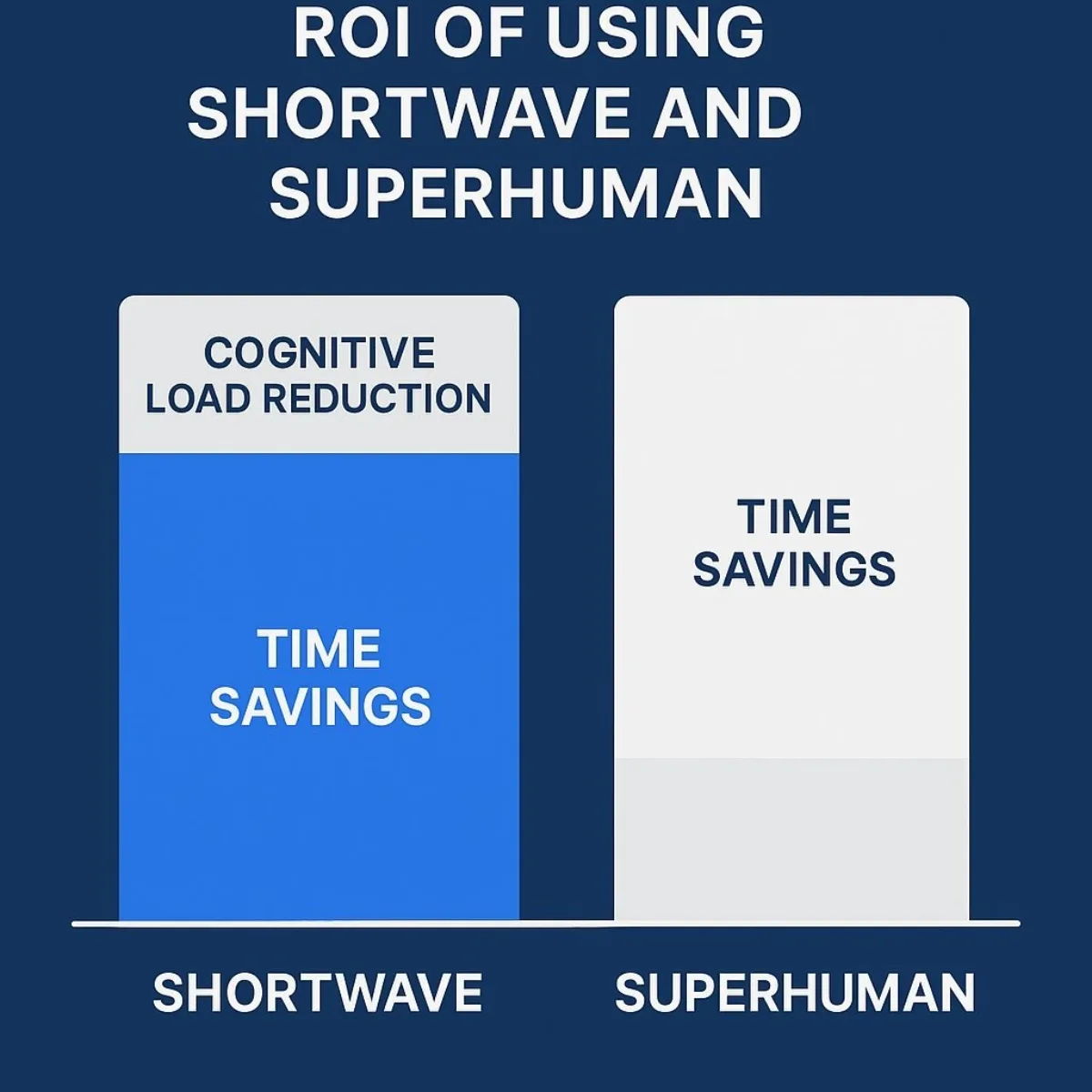
Section 2: The Real ROI: Will These Tools Actually Save Your Team Time?
For any executive, the ultimate question about a new technology investment is straightforward: "Is it worth it?" This section directly addresses the time-saving claims of both platforms to determine the tangible return on investment your team can expect.
Superhuman makes a bold and specific promise: to save its users "four hours per week". This quantifiable ROI is the cornerstone of its value proposition. The time savings are derived from a combination of factors: the platform's raw speed, which eliminates the loading and lag times of web-based clients; the efficiency of its keyboard-driven workflow, which minimizes clicks and context switching; and features like AI-powered replies and reminders that reduce the cognitive load of managing communications.
Shortwave's claim, while less specific, is equally compelling. It promises to make "inbox zero achievable 45% faster than in Gmail". For Shortwave, time savings come not from raw execution speed but from superior organization. By automatically bundling low-priority mail, turning actionable emails into a manageable to-do list, and enforcing a triage methodology, the platform reduces the time and mental energy spent sorting, prioritizing, and deciding what to do next. User testimonials for both platforms frequently confirm these productivity gains, with users reporting they feel more productive than ever and can finally get on top of their inboxes.
However, these gains are not instantaneous. Both platforms have a learning curve. Superhuman famously requires a 30-minute one-on-one onboarding call to instill its keyboard-centric workflow. Users note that while there is an initial time investment to break old habits, the long-term payoff is significant. Similarly, adopting Shortwave's "opinionated" method requires a conscious shift in behavior that takes time to become second nature.
This reveals that the platforms offer two distinct types of ROI. Superhuman's promise of saving four hours a week represents a direct, measurable time saving on the execution of email tasks. This is a hard ROI that can be easily calculated: hours saved multiplied by employee salary. Shortwave, on the other hand, offers an indirect, cognitive load saving . Testimonials for Shortwave speak of a changed "relationship with my inbox," feeling a "sense of peace," and email becoming "less of a chore". This represents a reduction in stress, burnout, and decision fatigue—a soft ROI that is harder to quantify but immensely valuable for improving focus and overall employee well-being. For deeper insight into how AI is shaping modern productivity, you may want to consult our comprehensive analysis of the AI landscape in 2025. A CFO may be more immediately persuaded by Superhuman's clear, quantifiable return. A CTO or Head of HR, however, might see greater long-term value in Shortwave's potential to create a more sustainable and less stressful work environment. A truly strategic evaluation must consider both forms of return.
Section 3: Feature Deep Dive: A Head-to-Head Analysis for Executive Teams
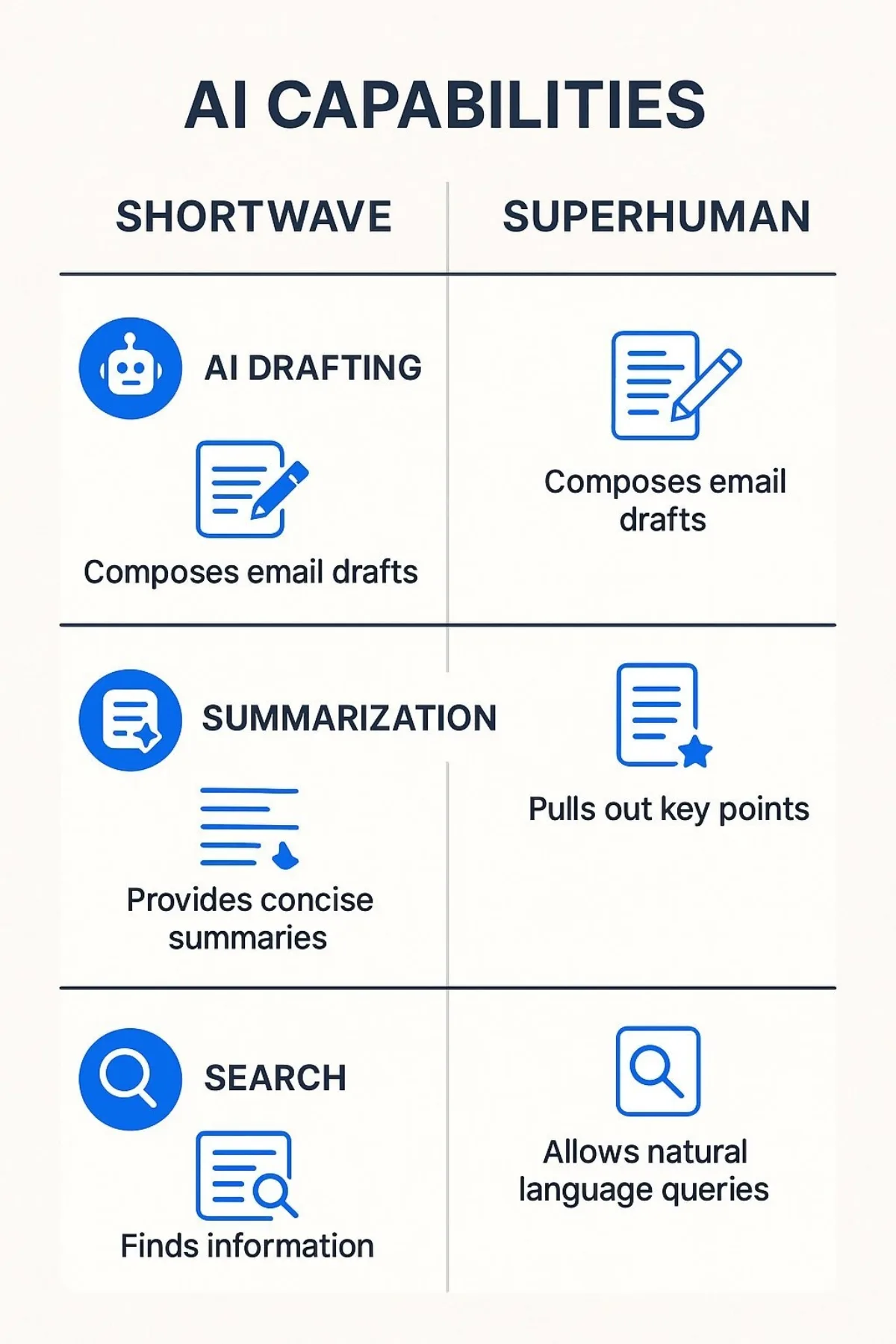
While philosophy and ROI provide a high-level framework, the decision to invest also hinges on a granular understanding of features. This section provides a head-to-head comparison of Shortwave and Superhuman across the three areas most critical to executive teams: AI capabilities, inbox organization, and team collaboration.
Subsection 3.1: The AI Co-pilot: Drafting, Summarizing, and Searching
Both platforms have heavily invested in AI to serve as an intelligent co-pilot, but their capabilities and focus differ in key areas.
- AI Email Drafting & Voice:
- Shortwave is widely praised for its AI's ability to learn a user's unique writing style from their email history. This results in AI-generated drafts that sound remarkably natural and personalized, a significant advantage for client-facing communication. Some users attribute this superior writing quality to its use of Claude's large language model. For executives exploring the rise of AI, machine learning, and LLMs in business tools, the impact is clear: these technologies can truly personalize your communications and accelerate productivity.
- Superhuman focuses on speed with its "Instant Reply" feature, which can generate a draft reply for every incoming email, and its "Compose with AI," which turns short phrases into a full message. While effective and fast, users sometimes find the tone generated by its OpenAI-powered model can be overly formal or generic for certain contexts.
- AI Summarization:
- Both tools excel at summarizing long, complex email threads, a feature users on both sides cite as a major time-saver. Superhuman's "Auto Summarize" feature is particularly noteworthy, as it provides a persistent, one-line summary at the top of every conversation that updates in real-time as new replies come in. Shortwave's AI summaries are also a core feature, allowing users to quickly grasp the key points of a discussion without reading the entire history.
- AI Search & Knowledge Retrieval:
- Both platforms replace cumbersome keyword searches with natural language queries, allowing users to ask questions like, "What was the address of that restaurant Mike suggested last month?". This turns the inbox into a searchable knowledge base.
- However, there is a critical limitation with Shortwave : the depth of its AI-powered search is strictly tied to its pricing tiers. The free plan only searches the last 90 days of history, while paid plans extend this to one year, three years, or five years, depending on the subscription level. This can be a significant drawback for users needing to access older information.
- AI Scheduling:
- Both tools leverage AI to streamline the tedious process of scheduling meetings. They can check calendar availability, propose times, and draft invitation emails. Shortwave's "Help me schedule" tool has been singled out by reviewers as a highlight feature. Superhuman's "Instant Event" is equally powerful, capable of creating a fully populated calendar event from the context of an email with a single tap.
Subsection 3.2: Inbox Organization & Workflow
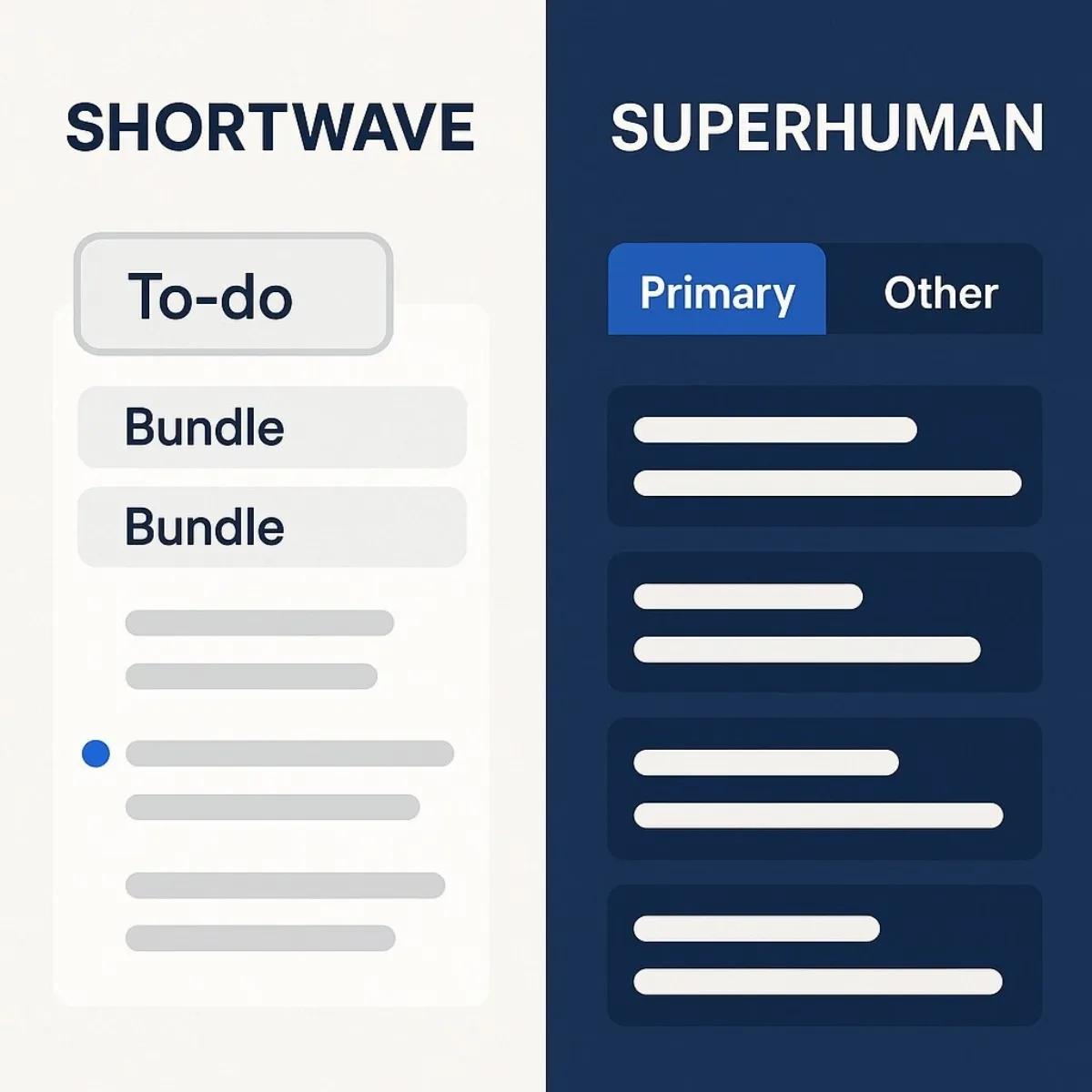
The platforms' differing philosophies are most apparent in how they help users organize their inboxes and manage their workflows.
- Core Method:
- Shortwave automates organization through
Bundles, which group low-priority mail like newsletters and social updates, and a dedicatedTo-Dossystem, which separates actionable emails from the main inbox flow. This approach is designed to let the system do the heavy lifting of sorting for the user. If you're interested in how structured digital systems can drive smarter decisions, explore our Business Leader’s Guide to Data Warehousing for a broader organizational perspective on information management. - Superhuman employs
Split Inbox, a powerful but manual system where users create their own custom "workstreams" based on specific filters (e.g., emails from VIPs, from the internal team, or calendar notifications). This gives the user precise control over how they triage their email in focused, manageable batches.
- Shortwave automates organization through
- Platform Support & App Experience:
- This is arguably the most important practical difference between the two. Superhuman supports both Gmail and Microsoft Outlook accounts , making it a viable option for nearly any business environment. Shortwave, in contrast, works exclusively with Gmail and Google Workspace accounts . For any organization that uses Microsoft 365, this makes Shortwave a non-starter.
- In terms of application performance, Superhuman offers a true native desktop app for both Mac and Windows, which users praise for its exceptional speed and stability. Shortwave's desktop application is a progressive web app (PWA), essentially a wrapper for its web version, which some power users find disappointing. Both platforms offer well-regarded and full-featured mobile apps for iOS and Android.
Subsection 3.3: Team Collaboration & Integrations
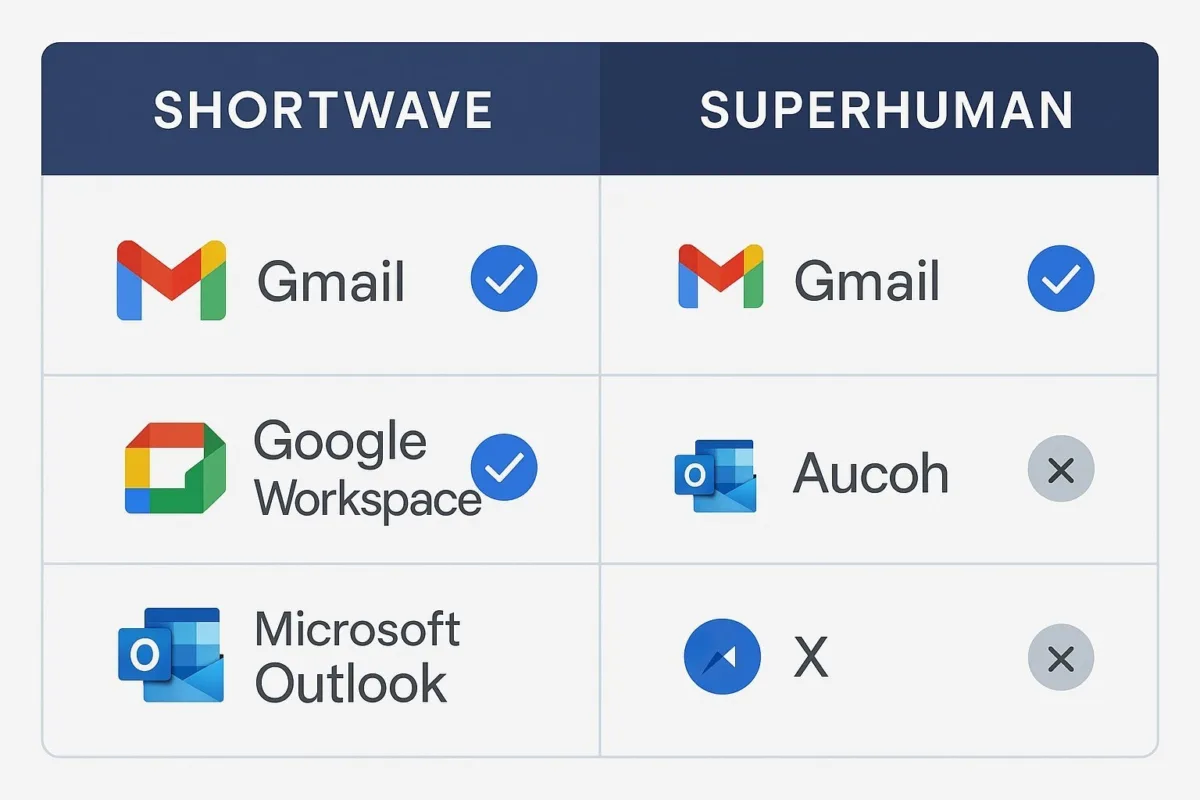
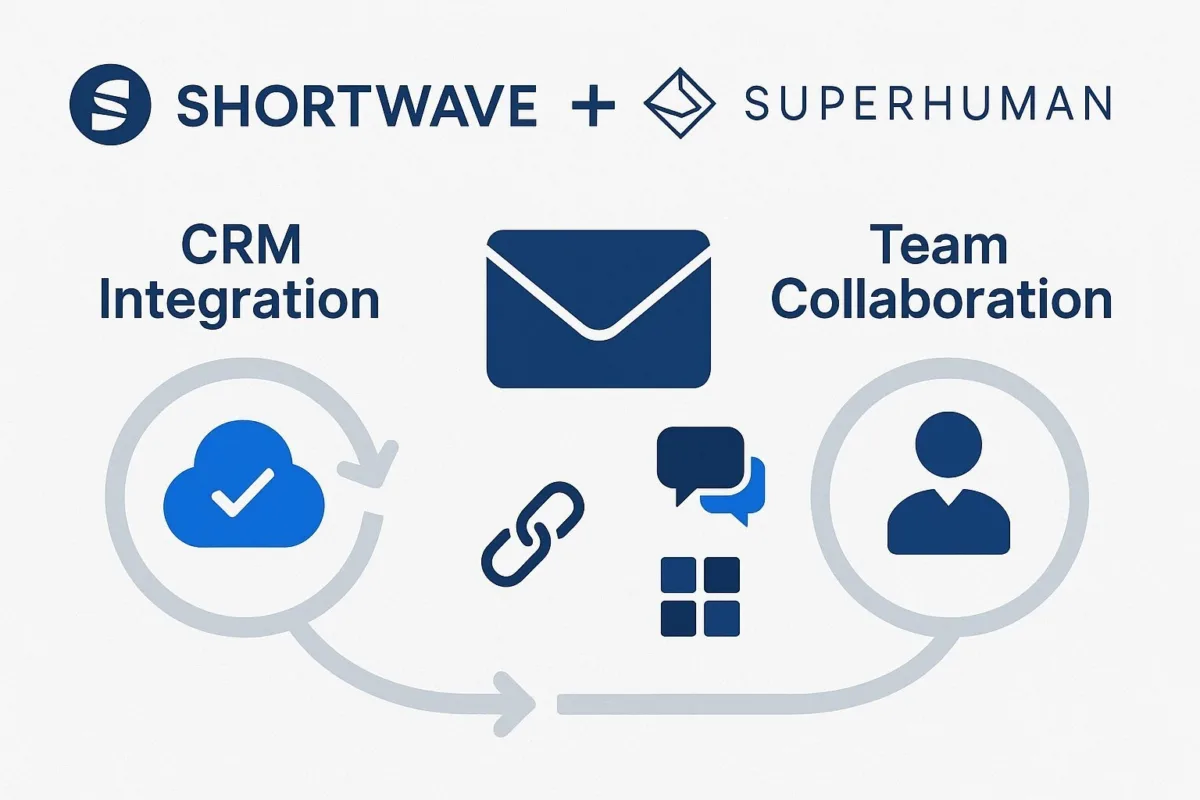
For executive teams, email is rarely a solo activity. The ability to collaborate seamlessly and integrate with other critical business systems is paramount.
- Core Collaboration:
- Both platforms significantly improve on the standard "forward" and "BCC" model. They offer shared threads or conversations and allow for private, in-line commenting, effectively turning an email thread into a mini-collaboration doc and eliminating the need to paste screenshots into Slack or Teams.
- Shortwave adds the ability to assign an email to a specific teammate, giving it a clear owner and status. Superhuman offers a unique "collision detection" feature that shows when a teammate is actively typing a reply to the same email, preventing duplicate work and crossed wires. For organizations focused on achieving seamless system integration and collaboration, this kind of real-time insight can be transformative for operational efficiency.
- CRM Integration:
- Superhuman has a decisive advantage here for any revenue-focused team. It offers direct integrations with Salesforce and HubSpot , which surface key customer and deal information directly in a sidebar within the email client. This allows sales and marketing professionals to have full context without leaving their inbox. It is worth noting, however, that some users have described the integration as "mediocre" and lacking the full feature set of the native CRM platforms.
- Shortwave currently lacks any direct CRM integration. This is a significant gap for sales, business development, and customer success teams, and users have explicitly requested this functionality.
- Read Receipts:
- Both platforms offer read receipts, providing valuable insight into recipient engagement. However, access to this feature differs. In Superhuman, it is a core feature that can be shared across teams, allowing a colleague to see if a recipient has opened an email even if they weren't the original sender. In Shortwave, read receipts are a premium feature, available only on the more expensive Business plan and higher, which costs a minimum of $24 per user per month when billed annually.
Section 4: At-a-Glance Comparison: Shortwave vs. Superhuman
For the time-constrained executive, a direct, scannable comparison of the most critical decision points is essential. The following table moves beyond a simple feature list to provide a strategic verdict for each category, translating technical capabilities into business implications. This structure is designed not just to present data, but to guide a strategic decision by answering the implicit "so what?" behind each feature. For example, platform support is not just a technical detail; for a CTO, it can be a non-negotiable factor that determines the viability of a tool across the entire organization, making it a major strategic consideration.
The Executive's Decision Matrix
| Feature | Shortwave | Superhuman | The Baytech Verdict for Executives |
|---|---|---|---|
| Core Philosophy | Automated Organization & Triage (The "Organizer") | Manual Speed & Keyboard-First Efficiency (The "Operator") | Choose Shortwave for process-driven teams (Ops, Eng). Choose Superhuman for velocity-driven teams (Sales, Exec). |
| AI Email Drafting | Learns your unique voice (powered by Claude). Praised for natural, personalized tone. | Instant draft replies (powered by OpenAI). Fast and effective, but can sound generic. | Shortwave is superior for client-facing roles requiring personalized communication (Marketing, BD). Superhuman is better for high-volume internal comms. |
| Platform Support | Gmail / Google Workspace Only . | Gmail & Microsoft Outlook . | Non-negotiable. Superhuman is the only option for Microsoft-based organizations or hybrid environments. A major strategic advantage. |
| Team Collaboration | Shared threads, comments, email assignment. | Shared conversations, comments, collision detection, Salesforce/HubSpot integration . | Superhuman's CRM integration makes it the clear winner for Sales, Marketing, and Customer Success teams, despite some user complaints about its depth. |
| Pricing Model | Freemium. Paid plans from ~$7/user/mo (annual) up to $36+/user/mo . | Premium Only. Starts at $25/user/mo (annual). | Shortwave offers a lower barrier to entry for piloting. Superhuman is a significant, but predictable, upfront investment. |
| Desktop App | Web wrapper (PWA). | Native Mac & Windows App. | Superhuman provides a superior, faster, and more stable desktop experience for power users. |
| Key Differentiator | Bundles & To-Dos: Automated, Inbox-style organization. | Speed & Split Inbox: Blazing-fast, keyboard-driven triage. | Depends on whether you want the app to organize for you or help you organize faster . |
Section 5: The Bottom Line: A Transparent Look at Cost vs. Value
A discussion of premium B2B software is incomplete without a frank analysis of cost. While list prices provide a starting point, a strategic evaluation requires a deeper look at the total cost of ownership (TCO) and the true value delivered at each price point.
Shortwave's Pricing Model: The Freemium Hook and the TCO Trap
Shortwave employs a tiered, freemium pricing model designed to attract a wide range of users. The plans include a Free tier, a Personal plan (~$7-8.50/mo), a Pro plan (~$14-18/mo), a Business plan (~$24-30/mo), and a Premier plan (~$36-45/mo).
The free plan serves as an effective trial but is intentionally limited to encourage upgrades. It restricts searchable email history to just 90 days and, most notably for business users, appends a mandatory "Sent with Shortwave" signature to all outgoing emails. The real challenge for businesses, however, lies in the paywalling of critical features. User forums reveal frustration that essential capabilities for professional teams, such as custom AI filters and read statuses, are locked behind the significantly more expensive Business and Premier tiers.
This creates a potential "TCO Trap." An organization might pilot Shortwave with its sales team on the Pro plan for $14 per user per month. However, once the team discovers that read receipts—a vital feature for sales outreach—require an upgrade to the Business plan at $24 per user per month, the per-seat cost jumps by over 70%. This kind of unpredictable cost escalation can be a significant headache for any CFO or department head managing a budget. For those evaluating true software ROI, see our CFO’s Guide to Calculating the ROI of Custom Software Development, which provides a comprehensive framework for weighing investments like these.
Superhuman's Pricing Model: The Predictable Premium
Superhuman takes the opposite approach with a simple, premium, and transparent pricing structure. It starts at $30 per month, with an annual plan available for $300, which equates to $25 per user per month. There is no free version, though 30-day trials are sometimes available through referral links.
The immediate reaction to this price is often "sticker shock," as it is undeniably one of the most expensive email clients on the market. However, the company frames this not as a cost, but as an investment. The target user is a high-value professional or "power user" for whom the promise of saving four hours a week provides a clear and substantial financial return that far exceeds the subscription fee.
While the upfront cost is high, it is predictable. A CFO can budget for Superhuman with certainty, knowing that all features, including its advanced AI and collaboration tools, are included in that single price. The choice for an executive is therefore not simply $14 vs. $25 . It is a strategic decision between a lower initial cost with the risk of future budget increases (Shortwave) and a higher but fixed and predictable investment (Superhuman). For organizations where budget predictability is a top priority, Superhuman's model may be the more prudent long-term choice.
Section 6: The Future Factor: Why Grammarly's Acquisition of Superhuman Changes Everything
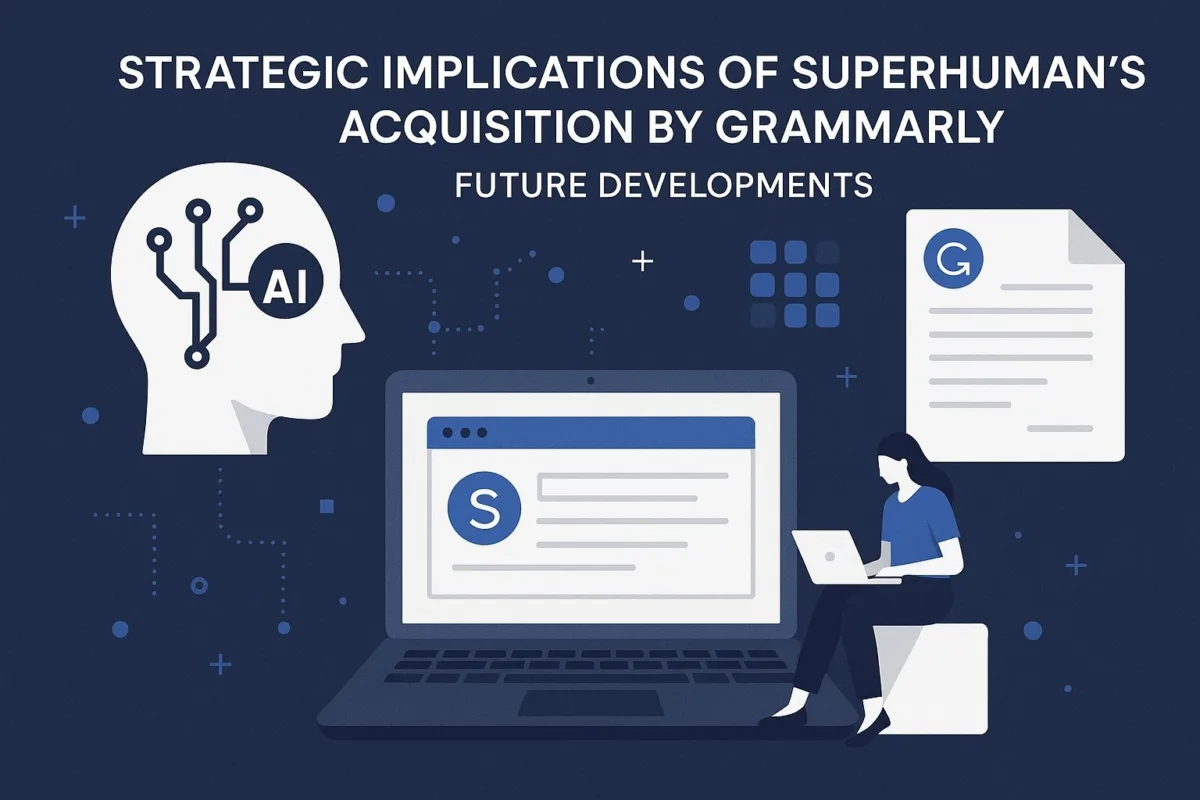
A tactical tool comparison is useful, but a strategic technology decision must also account for the future trajectory of the platforms. In mid-2025, a market-shifting event occurred: Superhuman was acquired by Grammarly. This development fundamentally changes the calculus for any executive evaluating these two tools.
Grammarly is not a small startup; it is a highly profitable technology giant with over 40 million daily active users and a formidable engineering infrastructure. The company's stated ambition is to evolve far beyond its roots as a writing assistant. Its vision is to build a comprehensive productivity suite powered by "Agentic AI," where multiple specialized AI agents collaborate to help users accomplish complex tasks. Grammarly has built what it calls an "AI superhighway," an integration layer that already works across more than 500,000 applications, and it sees email as the "perfect staging ground" for orchestrating these future agents.
For Superhuman, this means it is no longer just an email client. It is now the foundational communication surface for a platform with ambitions to compete directly with Google Workspace and Microsoft 365. With Grammarly's resources, Superhuman is set to accelerate its product roadmap, with plans to build out integrated calendar and task functionalities to create a more holistic productivity suite.
This acquisition reframes the decision from a choice between two email tools to a choice between a tactical solution and a strategic platform bet. Choosing Shortwave remains a tactical decision to acquire a best-in-class tool for optimizing the Gmail workflow. It is a relatively low-risk, predictable choice that solves a specific, immediate problem. Its potential, however, is largely confined to the email domain.
Choosing Superhuman, on the other hand, is now a high-risk, high-reward strategic bet on a future ecosystem. An organization adopting Superhuman today is buying into the promise of Grammarly's agentic AI vision. If this vision succeeds, early adopters will find themselves on a cutting-edge, deeply integrated productivity platform that could provide a significant competitive advantage. If the vision falters, they will be left with a very expensive, albeit excellent, email client. This is a classic strategic dilemma that CTOs and CEOs face regularly: do you invest in the proven, tactical solution or take a calculated risk on the potentially transformative platform of the future?
Conclusion: Making the Right Choice for Your Tech Stack in 2025
The debate between Shortwave and Superhuman is not about which email client is "better" in a vacuum, but which is strategically right for your organization's specific context, culture, and technology stack. The extensive analysis reveals clear profiles for the ideal user of each platform.
Who Should Choose Shortwave:
- Profile: Process-oriented teams and leaders—such as CTOs, Heads of Operations, and Project Managers—whose organizations are standardized on Google Workspace .
- Reasoning: These teams will derive the most value from Shortwave's methodical approach to organization, its automated bundling, and its task-management features. Its AI-powered writing, which learns a user's unique voice, is a distinct advantage for roles that require nuanced and personalized communication. The accessible entry-level pricing makes it easy to pilot, but leaders must perform due diligence on the total cost of ownership, carefully mapping their feature requirements to the pricing tiers to avoid unexpected budget increases.
Who Should Choose Superhuman:
- Profile: High-velocity, revenue-generating teams—such as Sales, Business Development, CEOs, and VCs—and any organization that uses Microsoft Outlook or operates in a hybrid email environment.
- Reasoning: These teams will see a direct ROI from Superhuman's unparalleled speed, keyboard-driven efficiency, and critical CRM integrations with Salesforce and HubSpot. For them, the high subscription price is a justifiable expense when the time saved translates directly to more deals closed or faster decisions made. The acquisition by Grammarly adds a compelling, albeit riskier, strategic dimension, making it a bet on the future of integrated, AI-driven productivity.
The Baytech Consulting Final Word
Ultimately, the "best" tool is the one that seamlessly integrates with your existing workflows and measurably improves your team's performance. The most effective way to determine this is through a structured pilot program. Before starting any trial, leaders should define clear, measurable success metrics. For a Superhuman pilot, this might be "reduce average lead response time by 15%." For Shortwave, it could be "reduce the time our project managers spend sorting email by 25%."
Choosing the right productivity tools is a critical strategic decision that impacts everything from operational efficiency to employee satisfaction. At Baytech Consulting, we help leaders navigate these complex choices to build a tech stack that doesn't just support their business—it accelerates it. Contact us to learn how we can help you assess the true ROI of your productivity tools and make technology a competitive advantage for your organization. For more on how software choices can drive operational efficiency, see our report on enhancing operational efficiency with custom software.
About Baytech
At Baytech Consulting, we specialize in guiding businesses through this process, helping you build scalable, efficient, and high-performing software that evolves with your needs. Our MVP first approach helps our clients minimize upfront costs and maximize ROI. Ready to take the next step in your software development journey? Contact us today to learn how we can help you achieve your goals with a phased development approach.
About the Author

Bryan Reynolds is an accomplished technology executive with more than 25 years of experience leading innovation in the software industry. As the CEO and founder of Baytech Consulting, he has built a reputation for delivering custom software solutions that help businesses streamline operations, enhance customer experiences, and drive growth.
Bryan’s expertise spans custom software development, cloud infrastructure, artificial intelligence, and strategic business consulting, making him a trusted advisor and thought leader across a wide range of industries.


